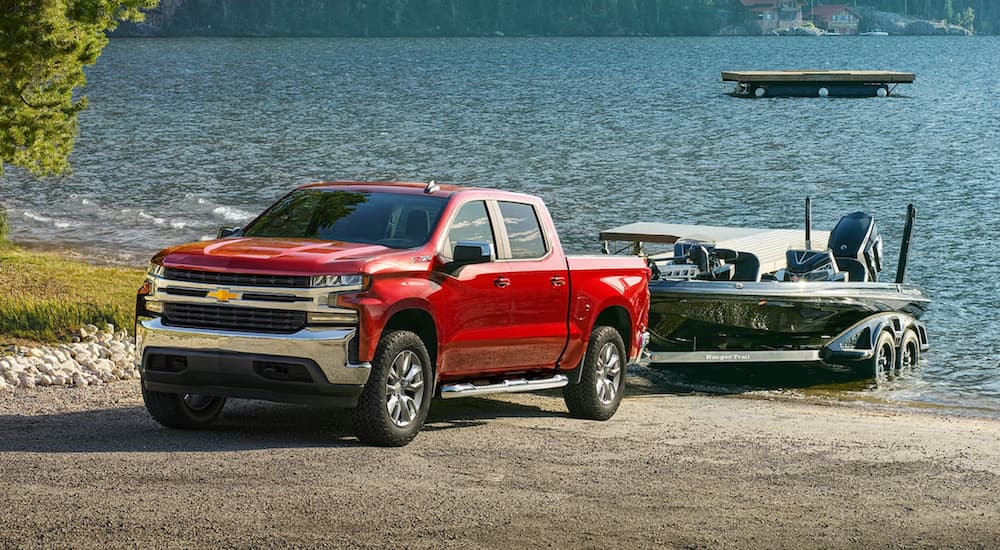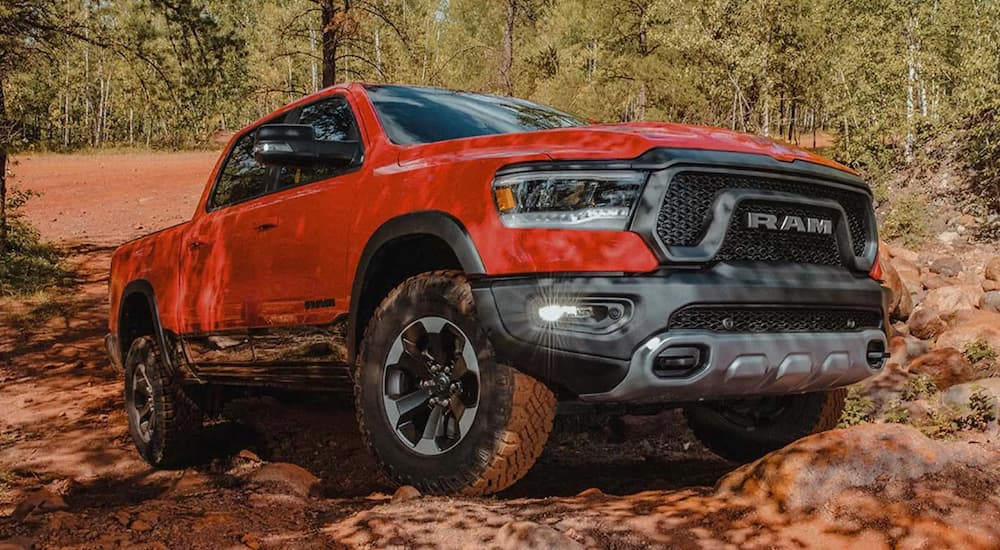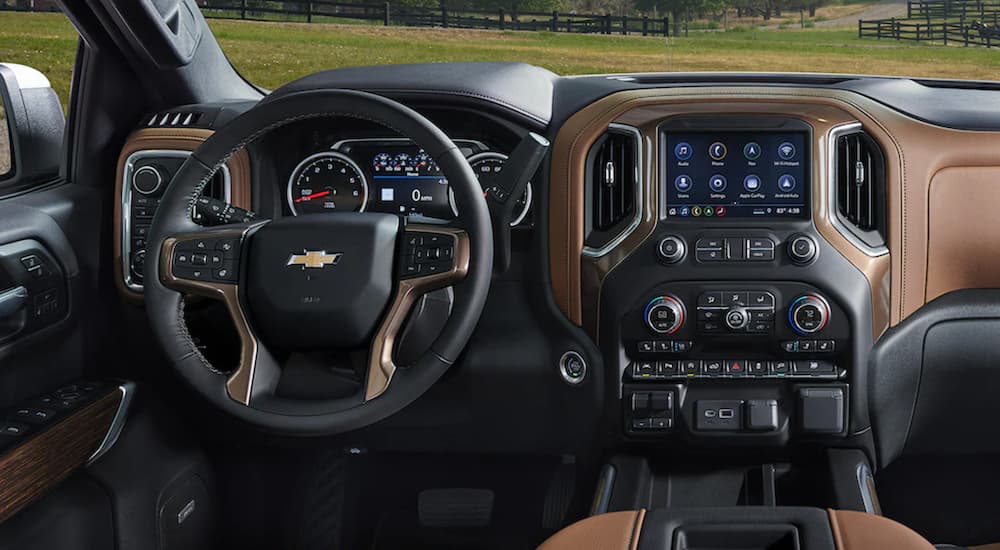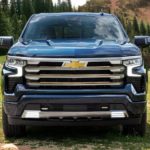That’s a great question and one that might seem initially simple to answer, though the reality is–as you might expect–a bit more complicated. It really depends on what we mean by “powerful,” and this is a term that gets thrown around a lot when discussing full-size trucks without always having a proper definition behind it. Are we just talking about horsepower or torque when looking at the 2022 Chevy Silverado 1500 vs 2022 Ram 1500? If so, then the Ram 1500 TRX (and only the TRX) does offer greater horsepower and torque than the Chevy Silverado 1500; otherwise, the Silverado has more horsepower.
Or, when we say “powerful,” are we really talking about capability and the kind of power to tow a massive amount of weight behind our truck? If that’s the case, then the Chevy Silverado is definitely a more powerful truck as it can have more than a quarter-ton greater towing than the Ram 1500 when you look at their highest capabilities. To really get to the bottom of this and see how these two trucks stack up, let’s cut through a lot of marketing talk and buzz words and just look at the numbers. This should give us the most accurate and transparent breakdown of what these pickups are capable of.
What is Power?
Ask a physicist or anyone with a particularly strong background in science, and they’ll tell you that “power” refers to energy that is transferred or converted over time. I could spend all day talking about force, energy, and power in terms of physics and classical mechanics, but that’s not really what we’re here for today. My point is simply that “power” has one clear definition in terms of physics, but that’s not really what anyone is talking about when an ad campaign or dealer website mentions that truck X is the “most powerful truck on the road.”
What kind of power are we talking about today? In order to really look at these two trucks, I think the fairest option is to consider multiple things that could qualify a pickup as being particularly “powerful.” To me, a truck with a lot of power is one that meets a number of high standards regarding possibilities for horsepower, torque, and doing actual work in terms of towing. If we’re just looking at something like horsepower, a sports car like a Corvette is certainly powerful–but you’re not about to tow 10,000 lbs behind one.
That’s why I think it’s important to get through the potential obfuscation of marketing words like “powerful” and actually look at numbers. Within the right context, numbers don’t lie–though context is important, otherwise you end up with something like the GMC Hummer EV and its much-ballyhooed “11,500 lb-ft of torque.” We all know that’s nonsense and relies on measuring torque in a way that no other truck does; while it’s not strictly a lie, it’s certainly breaking the rules for making any kind of fair comparison. So, let’s look at the 2022 Silverado 1500 and Ram 1500 to see what they have going on.
Chevy Silverado vs Ram 1500: Engine Options
First of all, let’s talk about the engine options in both of these trucks, because they both have multiple engines on offer. This means that when you look at their horsepower or towing, it’s important that you also keep in mind that it will greatly depend upon the engine you pick. In general (I’ll explain that qualification in a moment), both trucks have four engines to choose from, briefly explained as:
Chevy Silverado
- 2.7L Turbo I-4 High-Output
- 5.3L EcoTec3 V8
- 6.2L EcoTec3 V8
- 3.0L Duramax Turbo-Diesel I-6
Ram 1500
- 3.6L Pentastar V6 with eTorque
- 5.7L HEMI V8
- 5.7L HEMI V8 with eTorque
- 3.0L EcoDiesel V6
So far, so good. Just looking at the real basics here, these engines have pretty similar displacements (size), and generally, they seem rather comparable. There are a few notable differences, like the available mild hybrid system on the Ram 1500, but they both have three gas engines and a diesel to choose from. Where things get tricky is if you include the Ram 1500 TRX with the Ram 1500, rather than looking at it as its own model. The TRX features a 6.2L Supercharged HEMI V8 engine that is completely bonkers–if you include it, then the Ram 1500 can’t be beat; but if you don’t, then you get a more honest comparison across the board.
Chevy Silverado vs Ram 1500: Horsepower
Now that we’ve got a general sense of the engines available for these two trucks, let’s dig a bit deeper and start looking at different sorts of power they can offer. First up, let’s consider horsepower–this has to be a great metric since it has “power” right there in the name. I could spend about a thousand words explaining and diving into what horsepower means, but the simple version is that it’s the amount of power needed to accomplish 33,000 foot-pounds of work in one minute. Here’s how the previously mentioned engines stack up:
Chevy Silverado
- 2.7L I-4: 310 hp
- 5.3L V8: 355 hp
- 6.2L V8: 420 hp
- 3.0L I-6: 277 hp
Ram 1500
- 3.6L V6: 305 hp
- 5.7L V8: 395 hp
- 5.7L V8: 395 hp
- 3.0L V6: 260 hp
Simply going off raw numbers, it would be fair to say that the Chevy Silverado 1500 has an advantage, but it’s a pretty minimal one. With the base engines, it leads by 5 hp. The Ram really doesn’t have a comparable engine to the Silverado’s 5.3L V8; comparing the more-powerful V8s, Chevy leads with 25 hp. Finally, the diesel comes out on top again with 17 hp. So yes, in terms of this sort of power, Chevy has the advantage but are you ever going to feel a 5 hp difference? Not really.
Chevy Silverado vs Ram 1500: Torque
Torque is just as important as horsepower when looking at which truck is more “powerful,” and it’s something that manufacturers often brag about. While linear force is when something pushes or pulls on an object in a straight line to apply work to it, torque is a rotational force. For a truck, it involves the rotation of axles and wheels–it’s all more complicated than that, but we’re keeping things a bit simple for the sake of clarity. Torque is vital for a truck to push all its bulk up an incline, to get the wheels rolling in the first place, and to tow a bunch of weight behind it. So how do these trucks stack up?
Chevy Silverado
- 2.7L I-4: 420 lb-ft
- 5.3L V8: 383 lb-ft
- 6.2L V8: 460 lb-ft
- 3.0L I-6: 460 lb-ft
Ram 1500
- 3.6L V6: 269 lb-ft
- 5.7L V8: 410 lb-ft
- 5.7L V8: 410 lb-ft
- 3.0L V6: 480 lb-ft
For the most part, things are pretty comparable here as well, although I should point out that the standard engine on the Chevy truck really blows away the standard Ram engine for torque (this will impact towing down below). This is a new development based on improvements Chevy’s engineers made to the starting engine for the 2022 model, so if you go back a year, the difference here is not nearly so significant. Though we can see that the most powerful standard gas engine for the Silverado has quite a lot more torque than the Ram 1500’s, but the Ram’s diesel engine comes out on top. Just like with horsepower, though, these numbers often come down to bragging rights, and there’s little chance you’ll feel 20 lb-ft more torque. Comparing the standard engines though, that’s a huge difference that really does matter.
Chevy Silverado vs Ram 1500: Towing Capacity
Finally, let’s look at real-world numbers and actual stuff that impacts us while we use our trucks. Horsepower is great for bragging, and torque can certainly make a difference when driving up an incline, but towing capacity has much more meaning. So how do these trucks and their engines compare to each other? Here is each engine’s maximum towing capacity:
Chevy Silverado
- 2.7L I-4: 9,500 lbs
- 5.3L V8: 11,200 lbs
- 6.2L V8: 13,300 lbs
- 3.0L I-6: 13,300 lbs
Ram 1500
- 3.6L V6: 7,730 lbs
- 5.7L V8: 11,610 lbs
- 5.7L V8: 12,750 lbs
- 3.0L V6: 12,560 lbs
This is where I’d argue the Chevy really comes out on top–not in numbers that are just for bragging, but in something that matters. Looking at the starting engines, the Silverado can handle almost 2,000 lbs more than the Ram 1500, and that can make a huge difference. Even the Silverado’s diesel engine comes out on top by nearly 800 lbs, and their most-powerful gas engines have a 550 lb difference in Chevy’s favor. To be fair, you might not ever take advantage of that 550 lbs–but the huge advantage of the standard Silverado engine could have real-world applications. Ram loves to brag about the TRX’s 702 hp engine, and I don’t blame them, but as far as I’m concerned, the Chevy Silverado is a more powerful truck than the Ram 1500 overall.






